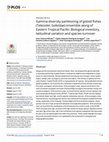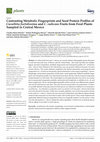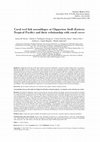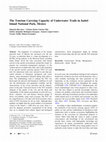Papers by Fabian Rodriguez

PLOS ONE, 2018
Gobies are the most diverse marine fish family. Here, we analysed the gamma-diversity (γ-diversit... more Gobies are the most diverse marine fish family. Here, we analysed the gamma-diversity (γ-diversity) partitioning of gobiid fishes to evaluate the additive and multiplicative components of α and β-diversity, species replacement and species loss and gain, at four spatial scales: sample units, ecoregions, provinces and realms. The richness of gobies from the realm Eastern Tropical Pacific (ETP) is represented by 87 species. Along latitudinal and longitudinal gradients, we found that the γ-diversity is explained by the β-diversity at both spatial scales, ecoregions and provinces. At the ecoregion scale, species are diverse in the north (Cortezian ecoregion) and south (Panama Bight ecoregion) and between insular and coastal ecoregions. At the province scale, we found that the species turnover between the warm temperate Northeast Pacific (WTNP), Tropical East Pacific (TEaP) and the Galapagos Islands (Gala) was high, and the species nestedness was low. At the ecoregion scale, historical factors, and phylogenetic factors have influenced the hotspots of gobiid fish biodiversity, particularly in the Cortezian, Panama Bight and Cocos Island ecoregions, where species turnover is high across both latitudinal and longitudinal gradients. At the provincial level, we found that the contributions of the β-diversity from north to south, in the WTNP, TEaP and Gala were high, as result of the high number of unique species. Species turnover was also high at this scale, with a low contribution from species nestedness that was probably due to the low species/gene flow within the provinces. These results highlight the importance and successful inclusion of a cryptobenthic fish component in ecological and biogeographical studies.

Plants, 2021
Cucurbita foetidissima and C. radicans are scarcely studied wild pumpkin species that grow in ari... more Cucurbita foetidissima and C. radicans are scarcely studied wild pumpkin species that grow in arid and semi-arid areas of Mexico and the United States. This study describes the morphological, proximal composition, metabolic finger-prints and seed protein profiles of C. foetidissima and C. radicans fruits collected in the wild during a one-year period in different locations of central-western Mexico. The results obtained complement the limited information concerning the fruit composition of C. foetidissima and greatly expand information in this respect regarding C. radicans. Morphology and proximal composition of their fruits varied significantly. Different metabolic fingerprints and seed protein profiles were detected between them and also with the chemical composition of domesticated Cucurbita fruits. The neutral lipids in seed, pulp and peels were rich in wax content and in unsaturated compounds, probably carotenoids and tocopherols, in addition to tri-, di- and mono-acylglycerols...

Biodiversity Data Journal, 2020
For more than 10 years (2007-2018), the benthic macroinvertebrates of Bahía de Chamela (Mexican P... more For more than 10 years (2007-2018), the benthic macroinvertebrates of Bahía de Chamela (Mexican Pacific) were sampled at 31 sites (0-25 m depth). A total of 308 species of the five main classes of benthic molluscs were obtained (106 bivalves, 185 gastropods, 13 polyplacophorans, two scaphopods and two cephalopods). This is a significant increase in the number of species (246 new records) compared to the 62 species previously recorded more than 10 years ago. The distribution in the 31 localities of the bay is given for the first time for most of the species, together with information on its ecological rarity (incidence in the samples). Two families of bivalves (Veneridae and Mytilidae) and three families of gastropods (Calyptraeidae, Muricidae and Collumbellidae) comprised ~ 30% of all species. Ecological rarity was evident with 45 families (45.0%) with only one species and 178 species (57.8%) collected in one site and 67 (21.8%) in two sites. The molluscs of Bahía de Chamela represe...

Diversity, 2022
Many crustacean species are obligate associates of pocilloporid corals, where they feed, reproduc... more Many crustacean species are obligate associates of pocilloporid corals, where they feed, reproduce, and find shelter. However, these coral-associated crustaceans have been poorly studied in the eastern tropical Pacific. Determining the crustacean richness and taxonomic distinctness could help in comparing different coral reefs and the potential effects of degradation. This study evaluated the spatio–temporal variation of the taxonomic diversity and distinctness of coral-associated crustaceans in four ecosystems of the Central Mexican Pacific (CMP) with different conditions and coral cover. In all ecosystems, 48 quadrants were sampled during the summer and winter for two years. A total of 12,647 individuals belonging to 88 species, 43 genera, and 21 families were recorded. The sampling effort yielded 79.6% of the expected species richness in the study area. Species rarity had 19% singletons, 4% doubletons, 22% unique, and 9% duplicate species; two species represented new records for ...
… marinas, 2011
... 3 Laboratorio de Ecosistemas Marinos y Acuicultura (LEMA), Departamento de Ecología, CUCBA, U... more ... 3 Laboratorio de Ecosistemas Marinos y Acuicultura (LEMA), Departamento de Ecología, CUCBA, Universidad de Guadalajara, Carretera Guadalajara–Nogales Km 15.5, AP ... en influir sobre la composición local de las especies y la diversidad en peces y corales: (a) el área del ...

Scientia Marina, 2017
The Mexican Central Pacific is located in a zone of oceanographic transition between two biogeogr... more The Mexican Central Pacific is located in a zone of oceanographic transition between two biogeographic provinces with particular conditions that affect the associated fauna. The objective of this study was to evaluate the variation of hermatypic coral assemblages in this region and to determine their relationship with the heterogeneity of the benthonic habitat and spatial variables. A total of 156 transects were carried out at 41 sites in the years 2010 and 2011. The sampling effort returned 96.7% of the coral richness expected for the area, with a total of 15 species recorded. The results showed that richness, diversity and cover of corals varied only at the site and state scales. However, the composition and coverage of all coral species, as well as the benthonic habitat structure, differed significantly across the study scales (i.e. sites, zones and states). Canonical redundancy analysis showed that variation in the richness, diversity and assemblages of corals was explained by t...

Scientia Marina, 2016
Clipperton Atoll, one of the most isolated coral reefs worldwide, is of great scientific interest... more Clipperton Atoll, one of the most isolated coral reefs worldwide, is of great scientific interest due to its geomorphology and high levels of endemism. This study explored the reef fish assemblage structure of Clipperton Atoll and its relationship with live coral cover. Nine stations were sampled at three sites and three depths (6, 12 and 20 m) around the reef, measuring fish species richness and biomass and hermatypic coral cover (at genus level). We evaluated variation in species richness, biomass and diversity of fish assemblages among sites and depths, as well as the relationship between the entire fish assemblage composition and live coral cover. The results showed that species richness and biomass were similar among sites, but differed across depths, increasing with depth. In contrast, diversity differed among sites but not among depths. Multivariate analyses indicated that fish assemblage composition differed among sites and depths in relation to changes in cover of coral of ...

ZooKeys, 2014
We describe the composition and distribution of bivalve molluscs from the sandy and rocky interti... more We describe the composition and distribution of bivalve molluscs from the sandy and rocky intertidal and the shallow subtidal environments of Bahía de Mazatlán, México. The bivalve fauna of the bay is represented by 89 living species in 28 families, including 37 new records and four range extensions: Lithophaga hastasia, Adula soleniformis, Mactrellona subalata, and Strigilla ervilia. The number of species increases from the upper (44) and lower intertidal (53) to the shallow subtidal (76), but only 11 (17%) have a wide distribution in the bay (i.e., found in all sampling sites and environments). The bivalve assemblages are composed of four main life forms: 27 epifaunal species, 26 infaunal, 16 semi-infaunal, and 20 endolithic. A taxonomic distinctness analysis identified the sampling sites and environments that contribute the most to the taxonomic diversity (species to suborder categories) of the bay. The present work increased significantly (31%) to 132 species previous inventories of bivalves of Bahía de Mazatlán. These species represent 34% of the bivalve diversity of the southern Golfo de California and approximately 15% of the Eastern Tropical Pacific region.

Environmental Management, 2013
The popularity of ecotourism in the marine protected areas of Mexico has increased over the last ... more The popularity of ecotourism in the marine protected areas of Mexico has increased over the last 10 years; in particular there is a large development of a SCUBA diving industry in the Mexican Pacific including Isabel Island. Given the risks associated with human activity in the marine environments around this island, we propose two ecotourism management strategies: (1) the creation and use of underwater trails, and (2) the estimation of the specific tourism carrying capacity (TCC) for each trail. Six underwater trails were selected in sites that presented elements of biological, geological, and scenic interest, using information obtained during field observations. The methodology used to estimate the TCC was based upon the physical and biological conditions of each site, the infrastructure and equipment available, and the characteristics of the service providers and the administrators of the park. Correction factors of the TCC included elements of the quality of the visit and the threat and vulnerability of the marine environment of each trail (e.g., divers' expertise, size and distance between groups of divers, accessibility, wind, coral coverage). The TCC values ranged between 1,252 and 1,642 dives/year/trail, with a total of 8,597 dives/year for all six trails. Although these numbers are higher than the actual number of recreational visitors to the island (*1,000 dives per year), there is a need for adequate preventive management if the diving sites are to maintain their esthetic appeal and biological characteristics. Such management might be initially directed toward using only the sites and the TCC proposed here.

The popularity of ecotourism in the marine protected areas of Mexico has increased over the last ... more The popularity of ecotourism in the marine protected areas of Mexico has increased over the last 10 years; in particular there is a large development of a SCUBA diving industry in the Mexican Pacific including Isabel Island. Given the risks associated with human activity in the marine environments around this island, we propose two ecotourism management strategies: (1) the creation and use of underwater trails, and (2) the estimation of the specific tourism carrying capacity (TCC) for each trail. Six underwater trails were selected in sites that presented elements of biological, geological, and scenic interest, using information obtained during field observations. The methodology used to estimate the TCC was based upon the physical and biological conditions of each site, the infrastructure and equipment available, and the characteristics of the service providers and the administrators of the park. Correction factors of the TCC included elements of the quality of the visit and the threat and vulnerability of the marine environment of each trail (e.g., divers' expertise, size and distance between groups of divers, accessibility, wind, coral coverage). The TCC values ranged between 1,252 and 1,642 dives/year/trail, with a total of 8,597 dives/year for all six trails. Although these numbers are higher than the actual number of recreational visitors to the island (*1,000 dives per year), there is a need for adequate preventive management if the diving sites are to maintain their esthetic appeal and biological characteristics. Such management might be initially directed toward using only the sites and the TCC proposed here.

Reef fishes are critical functional groups for coral reefs, where the diversity of the former var... more Reef fishes are critical functional groups for coral reefs, where the diversity of the former varies across different spatial scales. Multi-scale approaches are necessary to find this scale-dependence because the identification of such critical scales is fundamental to conserve coral reef biodiversity. For the first time, we present a study on fish diversity partition from the northern sector of the Mesoamerican Barrier Reef System (nsMBRS). In this area, coral reefs mainly present four habitats (e.g., lagoon, front, slope and terrace) and the spatial and environmental variables differ along a north-south gradient along the coast. This particular geomorphology provides an excellent opportunity to evaluate the reef fish diversity. Our objectives were to assess the inventory and differentiation diversity at habitat, reef and regional scales, and carry out additive diversity partitioning from sample to region scale. Total fish diversity () was partitioned into its additive diversity components (␣ s ,  s , ␣, , ␥ and ␦), which were evaluated using bootstrap and rarefaction procedures, non-parametric statistics, and non-linear and null models. We found that ␣ diversity was higher in the habitats front, slope and terrace, and  h diversity was highest between lagoons and fronts. The most developed reefs exhibited the highest ␣,  h , ␥ and ␦ r diversity. The  s and ␦ r diversity were essentials to keep ␥ and diversity. Additive partition outcomes showed that total fish diversity is determined mostly by reef scale followed per sample and habitat scales. This supports the hypothesis that inter-habitat and reef differences seem to strongly regulate local and regional species richness. We conclude that reef scale was the most important level for conserving and keeping the biodiversity at nsMBRS. KEYWORDS.-Coral reef fish, spatial diversity, nested-hierarchical design, spatial analysis, conservation, coral reefs, Mesoamerican Barrier Reef System, Caribbean Sea.

Hydrobiologia, 2015
We analyzed the trophic functioning of two Caribbean coral reefs with different disturbances, com... more We analyzed the trophic functioning of two Caribbean coral reefs with different disturbances, comparing their biomass flows, ecosystem development, and resilience. Cayos Cochinos is a protected reef impacted by tourism, artisanal fisheries, and continental river discharges, while Media Luna is an isolated reef located near to a lobster industrial fishery zone. Ecopath models were built to (1) estimate the ecosystem status-related properties; (2) evaluate the system recovery time; and (3) assess the fishery effects on species and functional groups. Our results indicate that the biomass of both systems is dominated by macroalgae (>75%), mainly at Cayos Cochinos that exhibit greater total system throughput. We show that the harvest of herbivores and coastal eutrophication causes increase in macroalgal biomass. The Media Luna ecosystem appears to be more mature and organized (Pp/R = 1.6, FCI = 6.95%), but is also less resistant to fishery impact (SRT = 10.79 and 21.72 years using bottom-up and top-down flow-control mechanisms, respectively) than Cayos Cochinos (SRT = 9.30 and 16.89). The benthic autotrophs, phytoplankton, and soft corals are the most important functional groups to the trophic functioning, resilience, and development of these ecosystems. However, fishery simulations also show that snappers and spiny lobster reduce the resilience of Cayos Cochinos and Media Luna, respectively.

Ecological and eco-social network models were constructed with different levels of complexity in ... more Ecological and eco-social network models were constructed with different levels of complexity in order to represent and evaluate management strategies for controlling the alien species Pterois volitans in Chinchorro bank (Mexican Caribbean). Levins´s loop analysis was used as a methodological framework for assessing the local stability (considered as a component of sustainability) of the modeled management interventions represented by various scenarios. The results provided by models of different complexity (models 1 through 4) showed that a reduction of coral species cover would drive the system to unstable states. In the absence of the alien lionfish, the simultaneous fishing of large benthic epifaunal species, adult herbivorous fish and adult carnivorous fish could be sustainable only if the coral species present high levels of cover (models 2 and 3). Once the lionfish is added to the simulations (models 4 and 5), the analysis suggests that although the exploitation or removal of...

PLOS ONE, 2016
This study evaluated the relationship between the indices known as the Reef Health Index (RHI) an... more This study evaluated the relationship between the indices known as the Reef Health Index (RHI) and two-dimensional Coral Health Index (2D-CHI) and different representative metrics of biological, ecological and functional diversity of fish and corals in 101 reef sites located across seven zones in the western Caribbean Sea. Species richness and average taxonomic distinctness were used to asses biological estimation; while ecological diversity was evaluated with the indices of Shannon diversity and Pielou´s evenness, as well as by taxonomic diversity and distinctness. Functional diversity considered the number of functional groups, the Shannon diversity and the functional Pielou´s evenness. According to the RHI, 57.15% of the zones were classified as presenting a "poor" health grade, while 42.85% were in "critical" grade. Based on the 2D-CHI, 28.5% of the zones were in "degraded" condition and 71.5% were "very degraded". Differences in fish and coral diversity among sites and zones were demonstrated using permutational ANOVAs. Differences between the two health indices (RHI and 2D-CHI) and some indices of biological, ecological and functional diversity of fish and corals were observed; however, only the RHI showed a correlation between the health grades and the species and functional group richness of fish at the scale of sites, and with the species and functional group richness and Shannon diversity of the fish assemblages at the scale of zones. None of the health indices were related to the metrics analyzed for the coral diversity. In general, our study suggests that the estimation of health indices should be complemented with classic community indices, or should at PLOS ONE |

Caribbean Journal of Science, 2008
Reef fishes are critical functional groups for coral reefs, where the diversity of the former var... more Reef fishes are critical functional groups for coral reefs, where the diversity of the former varies across different spatial scales. Multi-scale approaches are necessary to find this scale-dependence because the identification of such critical scales is fundamental to conserve coral reef biodiversity. For the first time, we present a study on fish diversity partition from the northern sector of the Mesoamerican Barrier Reef System (nsMBRS). In this area, coral reefs mainly present four habitats (e.g., lagoon, front, slope and terrace) and the spatial and environmental variables differ along a north-south gradient along the coast. This particular geomorphology provides an excellent opportunity to evaluate the reef fish diversity. Our objectives were to assess the inventory and differentiation diversity at habitat, reef and regional scales, and carry out additive diversity partitioning from sample to region scale. Total fish diversity () was partitioned into its additive diversity components (␣ s ,  s , ␣, , ␥ and ␦), which were evaluated using bootstrap and rarefaction procedures, non-parametric statistics, and non-linear and null models. We found that ␣ diversity was higher in the habitats front, slope and terrace, and  h diversity was highest between lagoons and fronts. The most developed reefs exhibited the highest ␣,  h , ␥ and ␦ r diversity. The  s and ␦ r diversity were essentials to keep ␥ and diversity. Additive partition outcomes showed that total fish diversity is determined mostly by reef scale followed per sample and habitat scales. This supports the hypothesis that inter-habitat and reef differences seem to strongly regulate local and regional species richness. We conclude that reef scale was the most important level for conserving and keeping the biodiversity at nsMBRS. KEYWORDS.-Coral reef fish, spatial diversity, nested-hierarchical design, spatial analysis, conservation, coral reefs, Mesoamerican Barrier Reef System, Caribbean Sea.
Ecological Modelling, 2015
ABSTRACT

Frontiers in Marine Science, 2015
As the impact of anthropogenic activity and climate change continue to accelerate rates of degrad... more As the impact of anthropogenic activity and climate change continue to accelerate rates of degradation on Caribbean coral reefs, conservation and restoration faces greater challenges. At this stage, it is of particular importance in coral reefs to recognize and to understand the structural spatial patterns of benthic assemblages. We developed a field-based framework of a Caribbean reefscape benthic structure by using hermatypic corals as an indicator group of global biodiversity and bio-construction patterns in 11 reefs of the northern sector of the mesoamerican barrier reef system (nsMBRS). Four hundred and seventy four video-transects (50 m long by 0.4 m wide) were performed throughout a gradient of reef complexity from north to south (∼400 km) to identify coral species, families and ensembles of corals. Composition and abundance of species, families and ensembles showed differences among reefs. In the northern zone, the reefs had shallow, partial reef developments with low diversities, dominated by Acropora palmata, Siderastrea spp., Pseudodiploria strigosa, and Agaricia tenuifolia. In the central and southern zones, reefs presented extensive developments, high habitat heterogeneity, and the greatest diversity and dominance of Orbicella annularis and Orbicella faveolata. These two species determined the structure and diversity of corals in the central and southern zones of the nsMBRS and their bio-construction in these zones is unique in the Caribbean. Their abundance and distribution depended on the reef habitat area, topographic complexity and species richness. Orbicella species complex were crucial for maintaining the biodiversity and bio-construction of the central and southern zones while A. palmata in the northern zones of the nsMBRS.

Revista de biología marina y oceanografía, 2010
This study describes the reef fish assemblages of Isabel Island and their relation with the benth... more This study describes the reef fish assemblages of Isabel Island and their relation with the benthos heterogeneity. A total of 39 visual transects from 19 different localities were performed in the zones North, South, East, and West around the island during December 2002, October 2004, and April 2005. The species composition and their abundance were registered in each transect. Video-transects were also performed to estimate the cover of benthic morpho-functional groups. A total of 9,956 specimens of fishes belonging to 118 species, 85 genera, and 51 families were registered. The 58.3% of the species have biogeographic affinity to the Panamic province. Six endemic species of the Mexican Pacific were registered, including two species endemic to the Gulf of California. According to the biological value index seven species were dominant in the island: Thalassoma lucasanum, Prionurus punctatus, Stegastes flavilatus, Halichoeres dispilus, Acanthurus xanthopterus, Abudefduf troschelii, and Johnrandallia nigrirostris. The indexes of diversity and evenness were not significantly different between the four zones of the island. However, there was a relation between the zones with higher biodiversity (South and East) and some components of the benthic habitat. The principal component analysis found that the cover of corals and rocks are highly related with the dominant species of the island, while the zones with highest proportion of sand, sponges, and gorgonians have less influence on fish diversity.

Uploads
Papers by Fabian Rodriguez